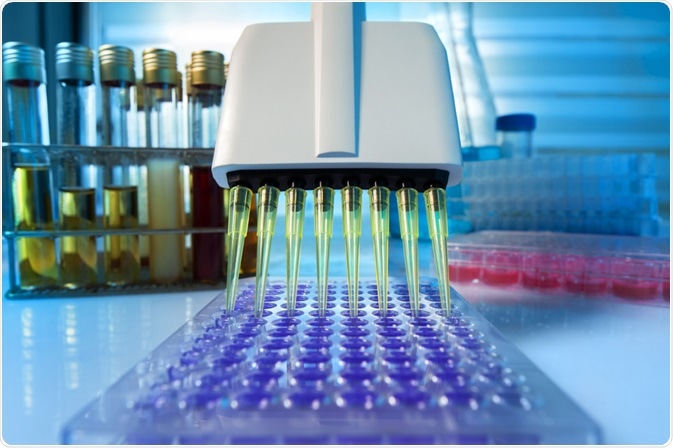Microplates have become ubiquitous lab consumables in the twenty-first century. They are used extensively in all biomedical testing facilities and can be seen holding samples, being transferred from one test bench to another, or being analyzed under a scanning tunneling microscope.
However, their history is rather short when compared to their evolution and proliferation across the world. In this article, we trace the timeline of microplates and examine the direction where they are headed in the coming future.

Image Credit: angellodeco/Shutterstock.com
Evolution
Pre-1990s era
There have been several inventions in science that were a product of circumstance. The microplate was also designed because the circumstances forced a microbiologist, Dr. Gyula Takatsy, to seek a cost-efficient solution for carrying out batch blood tests for a virus amid an influenza outbreak in Hungary in the 1950s.
He used calibrated spiral loops instead of a pipette, and glass-plates with wells in place of tubes for carrying out multiple simultaneous serial dilutions and invented the first 8 by 12 well microplate in 1951 during the process.
Simultaneously, in another corner of the world, American inventor John Liner devised a vacuum-based panel with 96 wells, and in 1953, gave the world the first disposable vacuum styrene-based panel.
Post-1953, he founded the American Linbro company and began mass production of the 96 well plates. This turned the invention from a scientific advancement to an engineering marvel, ready for commercialization, changing the landscape of biomedical testing.
In 1974, the first microplate was used for enzyme-linked immunosorbent assay and the levels of antibodies in blood were detected using it.
Over the years leading up to 1990, there were several advancements. The most prominent among them was the creation of a molded 96 well plate, machining the 96 well plate filter, and the black 96 well plate.
It was not until 1990 that the 96 well plates were optimized for maximum efficiency, and additional possible uses were explored. Companies in the USA and Europe pioneered these inventions and secured most patents in the process.
Post-1990s era
It was 1991 when the microplate industry truly reached scale, and wide commercial applications were explored. It was the year when the first 864 well plates were manufactured, and with it, the first 48 well plate and unifilter 92 well plates followed in 1992.
The first 1536 well plates followed in 1996, and the first 9600 well plates were made in 1997. The well shapes, sizes, bottoms, profiles, and filter technologies also kept on evolving in parallel. The main bottleneck for the wide adoption of the 384 well microplates was the difficulty in handling higher density liquids, which was solved by developing better supporting equipment over the years.
Over time, the washers, handlers, storage, and readers were also advanced, and the analytical techniques matched the pace of well development, which enabled microbiologists to develop RNAi technology for genome screening.
The efforts to develop microarrays continued into the last decade as well, and the increased thrust of the Barack Obama government on healthcare spending led to the proliferation of focused arrays in the markets.
The most recent commercial advancement was the combination of a microplate washer with the reagent dispenser in one instrument, to eliminate the maintenance of two separate instruments.
Microfluidic systems have also been developed, which facilitate drug discovery through high throughput more easily in contrast to existing technologies. Similarly, bio-therapeutics have been advanced significantly in recent times, and cancer indicating drugs are being produced with the aid of new label-free technologies.
The current market for microplates and supporting detection techniques is poised at USD 1.5 Billion and is expected to grow steadily (although growth rates are difficult to forecast given the nature of the research involved), with the market not showing any signs of plateauing out soon.
Conclusion
The evolution of the microplate has been rapid, with only half a century’s worth of effort producing more developments than ever before in the field of biotechnology. The microplate has gone a long way, with nano-plates already in production, and pico-plates not far away.
The production of such small well sizes means the associated testing costs can be reduced, and the precision can be improved even further when it comes to sample testing. Imagine extracting a fraction of the blood sample being drawn currently to run Hb tests and yielding accurate results at a fraction of the cost.
What limits the production of such pico-plates? It is the supporting equipment that will need to be evolved to handle an astonishingly high level of precision for minute volumes, and we are not quite there yet.
Nevertheless, there is a vast new ground to be broken, and the evolution of microplate technology will benefit microbiologists and the world alike.
Sources
- Banks, Dr. Peter (2019), The Microplate Market Past, Present and Future, Drug discovery world, DOI: https://www.ddw-online.com/enabling-technologies/p92824-the-microplate-market-pastpresent-and-future.html
- Blue, John (2010), Evolution of Microplate Technology, Lab manager, DOI: https://www.labmanager.com/lab-product/evolution-of-microplate-technology-19972
- Jaquith, Kevin (2014), The History Of The Microplate, wellplate, DOI: https://www.wellplate.com/the-history-of-the-microplate/
- Manns, Roy, History of Microplates, Plastics Historical Society, DOI: http://plastiquarian.com/?page_id=14361
- Soderqvist, Thomas (2010), The history of the microplate — a ubiquitous biomedical lab technology, University of Copenhagen, DOI: https://www.museion.ku.dk/en/2010/11/the-history-of-microplate-technology/
Further Reading
- All Microplate Content
- What are Microplates?
- Which Microplate is Best for your Assay?
- Manufacture and Composition of Microplates
Last Updated: Jan 7, 2021
Source: Read Full Article






